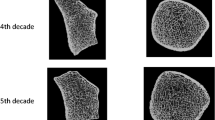Abstract
Bone densitometry has become a major tool for osteoporosis risk assessment. The traditional dual-energy X-ray absorptiometry (DXA) methods are able to evaluate the bone mineral content (BMC; mg/cm) and the areal density (BMD; mg/cm2), but only quantitative computed tomography (QCT) has the potential to measure the true volumetric bone density in the sense of mass per unit volume (mg/cm3). Peripheral QCT (pQCT) measurements were carried out at the non-dominant radius using a Stratec XCT 960 (Unitrem, Roma) in 241 postmenopausal and 29 premenopausal women. The sites of evaluation were both the ultradistal and the proximal radius. The technique used has a coefficient of variation of 2% and it allows separation of the bone section into trabecular and cortical bone on the basis of density threshold. Bone mass of radius, hip and spine was also evaluated by DXA procedures. The bone density data obtained by pQCT were significantly correlated with all DXA measurements. The correlation coefficients between their respective BMD values ranged from 0.48 to 0.75, but for the BMC values of the radius the correlation coefficients ranged from 0.82 to 0.93. The BMD values measured by DXA, but not by pQCT, were positively related with patient heights. All pQCT density measurements, including those obtained at the proximal radius and containing exclusively cortical bone, where negatively related with age and years since menopause. A partial volume effect, which is increasingly relevant the thinner are the bone cortices, might explain that. However, by applying increasing density thresholds, cortical bone density seems to decrease with age as a consequence of a gradual density diminution from the inner part of the bone cortex outwards. Trabecular bone density decreases with aging, but its overall mass does not change as a consequence of an age-related enlargement of trabecular area. Thus, the proportion of trabecular bone over total bone rises, and this might be relevant for our understanding of the age-related changes in bone turnover and rate of bone loss.
Similar content being viewed by others
References
Seely DG, Browner WS, Nevitt MC, Genant HK, Scott JC, Cummings SR. Which fractures are associated with low appendicular bone mass in elderly women? Ann Intern Med 1991;115:837–42.
Black DM, Cummings SR, Genant HK, Nevitt MC, Palermo L, Brower WS. Axial bone density predicts fractures in older women. J Bone Miner Res 1992;7:633–8.
Melton LJ III, Atkinson EJ, O'Fallon W, Wahner HW, Riggs BL. Long-term fracture prediction by bone mineral assessed at different skeletal sites. J Bone Miner Res 1993;8:1227–33.
Johnston C, Slemenda CW, Melton LJ III. Clinical use of bone densitometry. N Engl J Med 1991;324:1105–9.
Assessment of fracture risk and its application to screening for postmenopausal osteoporosis. Report of a World Health Organization Study Group. Geneva: World Health Organisation, 1994.
Schlenker RA, Von Seggen WW. The distribution of cortical and trabecular bone mass along the lengths of the radius and ulna and the implications for in vivo bone mass measurements. Calcif Tissue Int 1976;20:41–52.
Rüegsegger P, Durand EP, Dambacher MA. Differential effects of aging and disease on trabecular and compact bone density of the radius. Bone 1991;12:99–105.
Adami S, Kanis JA. Assessment of involutional bone loss: methodological and conceptual problems. J Bone Miner Res 1995:10 (in press).
Peel NFA, Eastell R. Diagnostic value of estimated volumetric bone mineral density of the lumbar spine in osteoporosis. J Bone Miner Res 1994;9:317–20.
Louis O, Willnecker J, Soykens S, Van de Winkel P, Osteaux M. Cortical thickness assessed by peripheral quantitative computed tomography: accuracy evaluated on radius specimens. Osteoporosis Int 1995;5:446–9.
Bohr H, Schaadt O. Bone mineral content of the femoral neck and shaft: relation between cortical and trabecular bone. Calcif Tissue Int 1985;37:340–4.
Schneider P, Butz S, Allolio B, Börner W, Klein K, Lehmann R, Petermann K, Tysarczyk-Niemeyer G, Wüster C, Zander C, Ziegler R, Reineres C. Multicenter German reference data base for peripheral quantitative computed tomography. Technology and Health Care 1995;3:69–73.
Thompson DD. Age changes in bone mineralization, cortical thickness, and haversian canal area. Calcif Tissue Int 1980;31:5–11.
Laval-Jeantet AM, Bergot C, Carroll R, Garcia-Schaefer F. Cortical bone senescence and mineral bone density of the humerus. Calcif Tissue Int 1983;35:268–72.
Barnett E, Nordin BEC. The radiological diagnosis of osteoporosis: a new approach. Clin Radiol 1960;11:166–74.
Adami S, Zamberlan N, Gatti D, Rossini M, Braga V, Broggini M, Zanfisi C. Computed radiographic absorptiometry and morphometry in the assessment of postmenopausal bone loss. Osteoporosis Int 1996;6:8–13.
Garn SM, Sullivan TV, Decker SA, Larkin FA, Hawthorne VM. Continuing bone expansion and increasing bone loss over a two-decade period in men and women from a total community sample. Am J Hum Biol 1992;4:57–67
Kalender WA, Felsenberg D, Louis O, Lopez P, Klotz E, Osteaux M, Faga J. Reference values for spongious and cortical bone mineral in single and dual energy quantitative computed tomography. Eur J Radiol 1989;9:75–80.
Eriksenand EF, Axelrod DW, Melsen F. Bone histomorphometry. New York: Raven Press, 1994.
Parfitt AM. The physiological and clinical significance of bone histomorphometric data. In: Recker RR, editor. Bone histomorphometry: techniques and interpretation. Boca Raton, FL: CRC Press, 1983:143–223.
Author information
Authors and Affiliations
Rights and permissions
About this article
Cite this article
Gatti, D., Rossini, M., Zamberlan, N. et al. Effect of aging on trabecular and compact bone components of proximal and ultradistal radius. Osteoporosis Int 6, 355–360 (1996). https://doi.org/10.1007/BF01623008
Received:
Accepted:
Issue Date:
DOI: https://doi.org/10.1007/BF01623008




